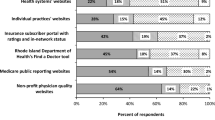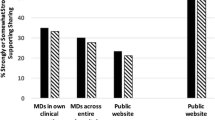Abstract
Background
Despite growing emphasis on public reporting of health care quality data, available data are often ignored.
Objective
To evaluate the usefulness of web-based physician-level data for patients choosing a new primary care physician (PCP).
Design
Patients seeking a new PCP (n = 2225) were invited to view web-based information including PCP credentials, personal characteristics, office location and hours, and patient experience scores. Patient experience scores included validated measures of interpersonal quality, appointment access, care coordination, health promotion, and patient recommendations of the PCP. After viewing the website, participants indicated their preferred PCP and completed a study questionnaire.
Results
Of the invited participants, 17% visited the website (n = 382). Patient experience scores were cited most frequently as important to physician choice (51%). Among these measures, patients’ highest priorities were interpersonal quality (37%) and patient recommendations of the PCP (41%). For patients citing these priorities, the odds of choosing a highly scored physician after viewing the data was nearly 10 times that of choosing such a physician by chance (odds ratio (OR) = 9.52 and 9.71, respectively).
Conclusions
Targeting patients known to be making a health care decision appears to promote the use of performance data. Patients particularly valued data concerning other patients’ experiences and, after viewing the data, made choices well-aligned with their priorities.
Similar content being viewed by others
References
Farley DO, Elliott MN, Short PF, Damiano P, Kanouse DE, Hays RD. Effect of CAHPS performance information on health plan choices by Iowa Medicaid beneficiaries. Med Care Res Rev. 2002;59:319–36.
Marshall MN, Shekelle PG, Leatherman S, Brook RH. The public release of performance data: what do we expect to gain? A review of the evidence. JAMA. 2000;283:1866–74.
Schneider EC, Epstein AM. Use of public performance reports: a survey of patients undergoing cardiac surgery. JAMA. 1998;279:1638–42.
Schauffler HH, Mordavsky JK. Consumer reports in health care: do they make a difference? Annu Rev Public Health. 2001;22:69–89.
Isaacs SL. Consumer’s information needs: results of a national survey. Health Aff (Millwood, Va.) 1996;15:31–41.
Hibbard JH, Jewett JJ. What type of quality information do consumers want in a health care report card? Med Care Res Rev. 1996;53:28–47.
Hibbard JH, Jewett JJ. Will quality report cards help consumers? Health Aff (Millwood, Va.) 1997;16:218–28.
Hannan EL, Racz MJ, Jollis JG, Peterson ED. Using Medicare claims data to assess provider quality for CABG surgery: does it work well enough? Health Serv Res. 1997;31:659–78.
Schneider EC, Epstein AM. Influence of cardiac-surgery performance reports on referral practices and access to care. A survey of cardiovascular specialists. N Engl J Med. 1996;335:251–6.
Gibbs DA, Sangl JA, Burrus B. Consumer perspectives on information needs for health plan choice. Health Care Financ Rev. 1996;18:55–73.
Hibbard JH, Peters E. Supporting informed consumer health care decisions: data presentation approaches that facilitate the use of information in choice. Annu Rev Public Health. 2003;24:413–33.
Hibbard JH, Jewett JJ. Will quality report cards help consumers? Health Aff (Millwood, Va.) 1997;16:218–28.
Safran DG, Karp M, Coltin K, Chang H, Li A, Ogren J, Rogers WH. Measuring patients’ experiences with individual primary care physicians. Results of a statewide demonstration project. J Gen Intern Med. 2006;21:13–21.
Rodriguez HP, von Glahn T, Rogers WH, Chang H, Fanjiang G, Safran DG. Evaluating patients’ experiences with individual physicians: a randomized trial of mail, internet, and interactive voice response telephone administration of surveys. Med Care. 2006;44:167–74.
Safran DG. Defining the future of primary care: what can we learn from patients? Ann Intern Med. 2003;138:248–55.
Stewart MA. Effective physician–patient communication and health outcomes: a review. CMAJ. 1995;152:1423–33.
Cleary PD. The increasing importance of patient surveys. Qual Health Care. 1999;8:212.
Fung CH, Elliott MN, Hays RD, Kahn KL, Kanouse DE, McGlynn EA, Spranca MD, Shekelle PG. Patients’ preferences for technical versus interpersonal quality when selecting a primary care physician. Health Serv Res. 2005;40:957–77.
Agency for Healthcare Research and Quality (AHRQ). Consumer Assessment of Healthcare Providers and Systems (CAHPS) website. Accessed on: April 16, 2007. http://www.cahps.ahrq.gov/content/products/CG/PROD_CG_CG40Products.asp.
National Quality Form (NQF) Website. Standardizing Ambulatory Care Performance Measures. Accessed on: April 16, 2007. http://www.qualityforum.org/projects/ongoing/ambulatory/index.asp.
Acknowledgements
This research was supported by the Robert Wood Johnson Foundation (Grant No. 050791) and the Pacific Business Group on Health. Salary support was also provided by grant T32-HS00060 from the Agency for Healthcare Research and Quality.
We gratefully acknowledge Dr. Michael Nelson and the Facey Medical Group for their support and participation in this research. We are also indebted to Dr. Andrew Maxfield, Dr. Margaret Gerteis, and BearingPoint, Inc. as invaluable resources in the design and analysis of this project. We also gratefully acknowledge Kara Cassidy, Angela Li, and their colleagues for their outstanding work in obtaining and managing the data.
This paper was presented at the Society of General Internal Medicine Annual Meeting in April, 2006 and the AcademyHealth Annual Research Meeting in June, 2006.
Conflicts of Interest
None disclosed.
Author information
Authors and Affiliations
Corresponding author
Rights and permissions
About this article
Cite this article
Fanjiang, G., von Glahn, T., Chang, H. et al. Providing Patients Web-based Data to Inform Physician Choice: If You Build It, Will They Come?. J GEN INTERN MED 22, 1463–1466 (2007). https://doi.org/10.1007/s11606-007-0278-1
Received:
Revised:
Accepted:
Published:
Issue Date:
DOI: https://doi.org/10.1007/s11606-007-0278-1




